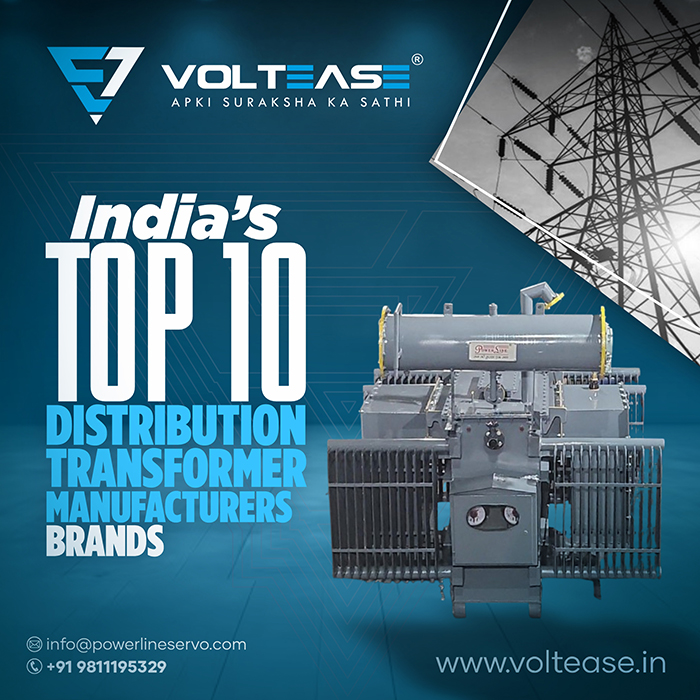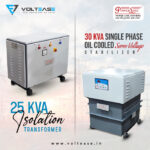Distribution transformers are essential components of electrical power setup. They are mainly used to receive high-voltage electricity from power stations and distribute low voltage for various applications for end users. It is the main conductor of the final stage of the power supply before it goes to the end users. Its key function is to reduce high-voltage electricity (typically 11 kV, 22 kV, or 33 kV) to a usable voltage (400V/230V). It is mounted on poles or installed on the ground and located near the consumption region.
Voltease is one of the reputed manufacturers of distribution transformers. We manufacture these under ISO 9001:2000 and BIS certification. Our distribution transformers are preferred for efficient step-down, robust insulation, and reliable safety from electrical failure, overarching, overloading, and short circuits. We cater to a large number of industries, residential and commercial clients in power supply in homes, offices, and industries, and renewable energy integration.
Applications of Distribution Transformers
- Petrochemical Plants
- Pharmaceutical Industry
- Textile Industry
- Plastic Manufacturing
- Mining Operations
- Cement Plants
- Steel Industry
- Hydropower Projects
- Solar Power Farms
- Wind Power Projects
- Oil Refineries
- Construction Sites
- Automobile Manufacturing
- Hospitals
- Hotels & Resorts
- Shopping Malls
- High-Rise Buildings
- Residential Societies
- Office Complexes
- Data Centers
- Airports
- Railways
- Metro Stations
- Educational Institutes
- IT Parks
Types of Transformers
While we discuss the distribution transformers, we must understand that it is a type of broad classification of transformers. A transformer is an electrical device used to transfer electrical power in the same frequency through electromagnetic conduction between two or more circuits. Though it is a complex assembly of various components, its main function is to increase or decrease voltage at different stages of power supply while maintaining the same frequency. All transformers work on the same principle, that is – Faraday’s Law of Electromagnetic Induction. However, there are many types with variations in design, configuration, function, and application. Let’s explore the many types of transformers offered by Voltease:
Distribution Transformer
As discussed earlier, distribution transformers are the main components of the final stage of the power supply before the electricity reaches the consumers. It steps down the voltage from a high-voltage source. The key components of a distribution transformer include – a magnetic core, windings, insulating oil or epoxy resin, a conservator tank, a breather unit, a Buchholz relay, a pressure relief device, bushing, tap changers, lightning arresters, and terminals.
Step Down and Step Up Transformers
A Step-Up Transformer and a Step-Down Transformer are types of electrical transformers designed to adjust voltage levels. A Step-Up Transformer increases the voltage by having more turns on the secondary coil than the primary coil, making it ideal for power transmission over long distances where high voltage is necessary for efficient energy delivery, which is then reduced for use in homes and industries. On the other hand, a Step-Down Transformer decreases the voltage by having fewer turns on the secondary coil compared to the primary coil, making it suitable for power distribution to safely lower voltage for household or industrial applications. Feature of step-up and step down transformers by Voltease:
- 1KVA to 300KVA maximum capacity heavy-duty continuous-use
- One grounded outlet in front of the unit (accepts 3 or 2 prongs US and Euro plugs)
- Hard wired
- Durable design with a heavy-duty cord
Isolation Transformer
Isolation transformers are unique in the sense that they transfer power without electrically connecting the power source and load. The primary and secondary windings are coupled, but there is no electrical connection between them. This is done to isolate the power source from the load to prevent short circuits and other faults from reaching the load. These are commonly used in sensitive equipment like medical devices, laboratory instruments, and industrial machinery to enhance safety and prevent electrical shock. Besides, it also reduces noise and disturbances in sensitive electronic circuits. Voltease ensures superior durability, enhanced protection against electrical disturbances in its isolation transformers.
Neutral Transformer
Neutral transformers are used where the neutral point in a power system does not exist. It establishes a connection between the Earth and the low or high-voltage distribution networks. The neutral point is crucial in systems that require a stable reference for voltage or current measurements. These are often used in three-phase systems to provide a return path for current and to balance the load across phases. Neutral transformers by Voltease use special winding arrangements like zig-zag or star-delta to achieve a neutral point, with a frequency up to 50 Hz.
Constant Voltage Transformer
Constant Voltage Transformer is used where output stable voltage is required, even if there are variations in input voltage. It achieves stability by using magnetic elements (such as an iron core) and capacitive or inductive components to stabilize the output. Unlike other transformers, which are used to step up or step up voltage, these are used to maintain constant voltage delivered to the sensitive equipment. Constant Voltage Transformers by Voltease are available in 150VA TO 10KVA capacity, and the output voltage delivered is 230 V AC (+/- 1.5%).
Dry Type Transformers
This is a special type of distribution transformer that does not use oil as a coolant in the transformer. It avoids the risk of fire by not using a combustible liquid. The windings are insulated by using solid materials like epoxy resin. Voltease provides these transformers to cater to areas where fire safety is a crucial consideration. It requires low maintenance as there is no oil to create contamination. Voltease offers this in 2 variants- Cast Resin dry type transformer and Vacuum Pressure Impregnated dry type transformer.
HT-AVR Transformer with Built-In AVR
The full form of the HT-AVR transformer hints at its function, which is- High Tension (HT) Transformer with an Automatic Voltage Regulator (AVR). Used for stepping down the voltage in a high-tension environment like hospitals, laboratories, and electronics industries, it contains an AVR feature to stabilize the voltage regardless of the fluctuations. This protects equipment from potential damage and ensures smooth operations. Voltease provides the HT-AVR Transformers with a capacity from 100 KVA to 10MVA.
Top 10 Distribution Transformer Manufacturers in India
Here is the list of India’s Top 10 Distribution Transformer Manufacturers & Suppliers.
- Voltease
- Kotson Pvt. Ltd.
- EVR Power
- Bharat Heavy Electricals Limited (BHEL)
- ABB India
- Kirloskar Electric Company Limited
- Siemens India
- Alstom T&D India
- Uttam Bharat
- Rajasthan Powergen Transformer Pvt. Ltd
FAQs
1. What is a Distribution Transformer?
Ans. A distribution transformer is an electrical device used to step down the voltage from the input source and distribute it to end users. They reduce voltage suitable for homes and businesses. It works on the principle of electromagnetic induction to change the voltage of electrical power.
2. What are the key benefits of using a distribution transformer?
Ans. Distribution transformers are designed to minimize energy loss and protect electrical grids and equipment. These are available in different sizes and variants to adapt to different power requirements
3. What is the lifespan of a distribution transformer?
Ans. The lifespan of the distribution transformer depends upon the quality of manufacturing, operating conditions, maintenance, loads, etc. Typically, it ranges between 25 to 40 years.
4. What is a Dry-type Transformer?
Ans. A dry-type transformer is a specialized distribution transformer that eliminates the need for oil as a coolant. By forgoing the use of combustible liquids, it significantly reduces the risk of fire. Instead, the windings are insulated with solid materials, such as epoxy resin, ensuring enhanced safety and reliability.
5. How often should a distribution transformer be maintained?
Ans. A distribution transformer should undergo annual inspections. Every 3-5 years Oil Testing and Thermographic Inspections. Every 5-10 years Dissolved Gas Analysis and Insulation Resistance Testing. If the transformer experiences an overload, short circuit, or any other unusual event, a thorough inspection should be performed immediately to check for internal damage or deterioration.


